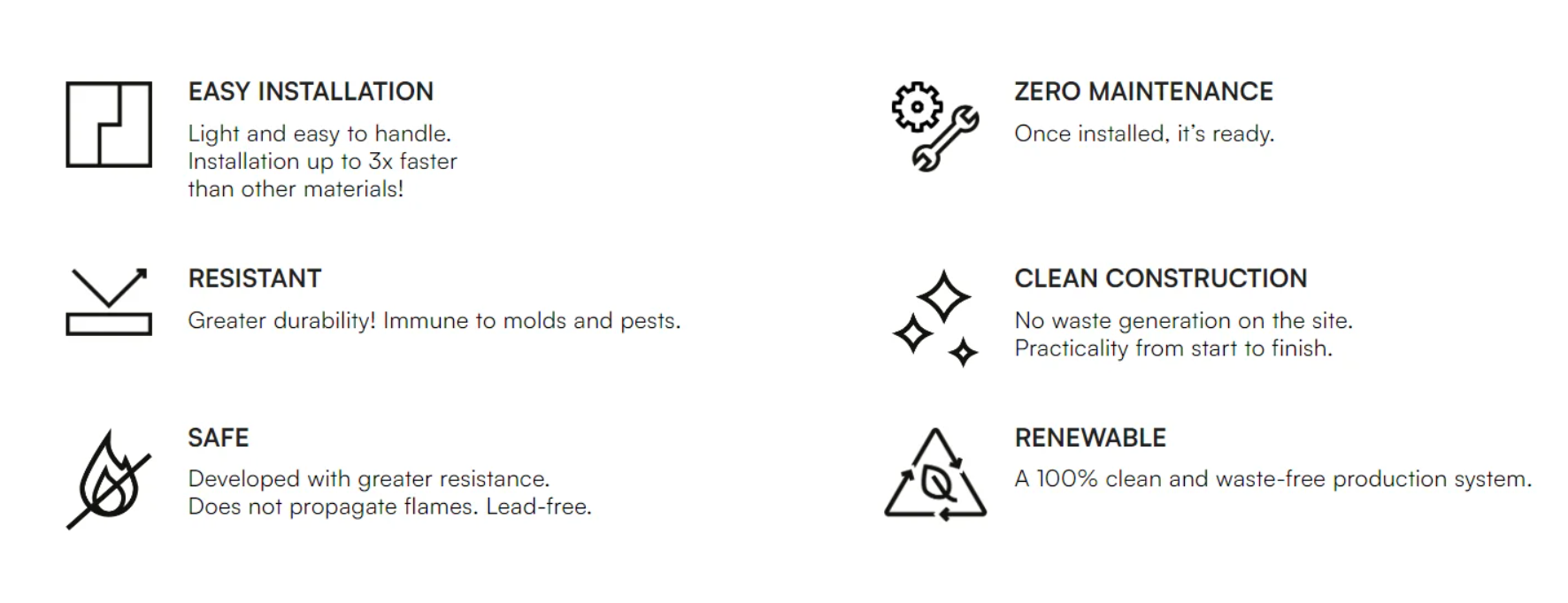Wall Panels, Vinyl
Vinyl Wall Panels Installation Guide: Tips for Applying Teto Vinilico
Are you ready to transform your space with stylish and durable vinyl wall panels? Installing Teto Vinilico not only enhances the aesthetic appeal of your interiors but also offers a practical and lasting solution.
In this guide, we’ll walk you through the process of installing Teto Vinilico vinyl wall panels, pinpointing common pitfalls to avoid, and sharing best practices to ensure a smooth application. Whether you’re a seasoned DIY enthusiast or a newcomer to home improvements, this guide will help you achieve professional-level results. Take a look!
Understanding Teto Vinilico Vinyl Wall Panels

Before diving into the installation process, let’s understand what makes Teto Vinilico a top choice. Brazilian Lumber specializes in manufacturing and importing the highest quality materials, including our Teto Vinilico vinyl wall panels.
Known for their durability, moisture resistance, and versatile designs, these panels are ideal for both residential and commercial spaces. They are especially popular in areas that demand both functionality and style, like kitchens, bathrooms, and retail environments.
Materials and Tools Required
To ensure you are well-prepared, here’s a list of materials and tools you will need:
- Teto Vinilico vinyl wall panels
- Measuring tape
- Level
- Utility knife
- Adhesive (specific to vinyl panels)
- Caulk gun
- Rubber mallet
- Jigsaw (for custom cuts)
- Sandpaper or a file (for smoothing edges)
Step-by-Step Installation Guide: How To Hang Vinyls on Wall
Preparing Your Wall
- Clean the Surface: Start by cleaning the wall thoroughly. Remove any dust, dirt, or grease. The wall surface should be dry, smooth, and free from any imperfections to ensure the adhesive bonds well.
- Measure and Plan: Measure your wall and plan the layout of the panels. It’s important to think about the placement of each panel to minimize waste and ensure the pattern matches up aesthetically.
Cutting and Fitting Panels
- Measure and Mark: Measure and mark where you need to cut the panels. Use a straight edge to ensure your lines are clean and straight.
- Cutting: Using a jigsaw or utility knife, cut the vinyl panels according to your marks. If using a jigsaw, ensure the blade is suitable for plastic materials to avoid chipping.
- Smooth Edges: Once cut, use sandpaper or a file to smooth out any rough edges on the panels.
Applying the Adhesive
- Apply Adhesive: Apply a uniform layer of adhesive on the back of each panel using a caulk gun. Be sure to follow the manufacturer’s instructions regarding adhesive application.
- Position the Panel: Carefully position the panel against the wall. Use a level to ensure it is perfectly vertical or horizontal, depending on your layout.
- Secure the Panel: Press the panel firmly against the wall. Use a rubber mallet to gently tap the panel to strengthen the bond and eliminate any air bubbles.
Repeating the Process
Repeat the process for each panel, ensuring that the edges meet tightly and the alignment remains consistent. If you encounter outlets or switches, measure and cut the panels to fit around them precisely.

Common Pitfalls to Avoid
- Inadequate Surface Preparation: Not cleaning or smoothing the wall can lead to poor adhesion. Ensure the wall is impeccably prepared before starting.
- Misalignment: Once a panel is adhered, repositioning can be difficult. Take your time to align each panel correctly before applying pressure.
- Ignoring Expansion Gaps: Vinyl can expand and contract slightly with temperature changes. Leave a small gap at the edges of the wall to accommodate this movement.
Best Practices for a Smooth Application
- Check Levels Frequently: Use a level to check each panel as you go. Consistency is key to a professional-looking finish.
- Work in Sections: Complete one section of the wall at a time to maintain focus and ensure alignment.
- Seal Edges: Once all panels are installed, seal the edges with appropriate caulking to prevent moisture from getting behind the panels.
Advantages Of Vinyl Over Wood

Vinyl offers several advantages over wood, especially in terms of durability and maintenance. It is resistant to moisture, making it ideal for humid or wet environments where wood can warp or rot.
Vinyl is also less susceptible to scratches and dents, maintaining its appearance over time with minimal upkeep. Additionally, vinyl is often more affordable and offers a variety of designs and colors, providing flexibility in aesthetic choices without the need for staining or painting.

Why Teto Vinilico is Your Best Option for Vinyl Wall Panels and Vinyl Ceilings
When it comes to upgrading your interiors, Teto Vinilico is an excellent choice for vinyl wall panels and ceilings. These products are known for their superior durability and quality, perfect for high-traffic areas. With a variety of textures, colors, and finishes, Teto Vinilico can seamlessly mimic natural materials like wood and stone, enhancing any décor style.
Additionally, their moisture resistance makes them ideal for humid environments, preventing mold and mildew buildup.

Installing vinyl wall panels like Teto Vinilico can dramatically change the look and feel of any room. With the right tools, careful planning, and attention to detail, you can achieve a seamless and durable installation. Remember to take your time and follow these steps closely for the best results. Happy DIY-ing with Teto Vinilico!














